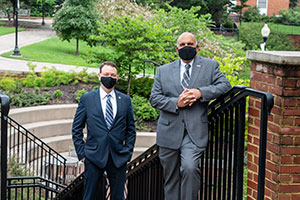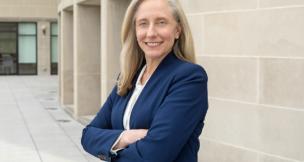The mother of innovation
Pandemic sparks creative teaching, outreach at UMW
Emily Freehling //September 28, 2020//
The mother of innovation
Pandemic sparks creative teaching, outreach at UMW
Emily Freehling //September 28, 2020//
Don’t try to be something you’re not.
That’s one way to sum up the approach that Troy Paino has taken to guiding the University of Mary Washington in Fredericksburg since assuming the school’s presidency in July 2016.
“I knew as an outsider that Virginia had a crowded and competitive marketplace for higher education,” says Paino, who previously served as president of Missouri’s Truman State University. “I don’t think I fully appreciated it until I got here.”
A major focus of Paino’s tenure so far has been helping Mary Washington find its identity in a crowded higher education market. The university has been engaged in a rebranding effort for the past year. The brand concept of “education that matters” was presented to the board of visitors at its July planning retreat.
University officials and representatives from their branding firm, Atlanta-based Mindpower, told the board they are reworking the concept to avoid any appearance of appropriating language from the Black Lives Matter movement. However, university leaders agreed that the underlying concept of UMW as an institution that inspires “meaningful inquiry and action for a complex world” was on target. Full rollout is expected in 2021.
Paino says the branding process helped the school home in on what distinguishes it: a small environment where students can form tight relationships with each other and faculty, and a commitment to a liberal arts education that is forward-looking and applicable to the modern workplace.
For Paino, part of the challenge was getting people to stay focused on those aspects and not to attempt to make UMW resemble other schools.
“People when I got here were thinking, ‘Do we need to have football? [Division I] athletics? Greek life?’ All these [are] things we don’t have,’” Paino recalls. “The absence of those things speaks pretty profoundly to who we are. This is a community that is inclusive, that is accepting of difference, that really is committed to the notion of social uplift and community service, and a lot of those schools who have those other things, that is what they become known for.”
Paino compares Mary Washington to James Madison University. Both schools were founded in 1908 as women’s colleges. And both eventually became coed. (JMU admitted men in 1946, while Mary Washington did in 1970.)
While JMU pursued a path of becoming a comprehensive university with Division I athletics and grew to a population of more than 20,000 students, UMW took a different direction.
Mary Washington attained university status in 2004 with the addition of its College of Graduate and Professional Studies in Stafford County, but its graduate student population has remained small (306 students in 2019), and its undergraduate enrollment has remained around 4,200 to 4,500 for the past decade.
“There seemed to be a push toward enrollment growth, and an investment in things that projected the school growing from 4,000 to … 6,000 students,” Paino says. “I said, ‘Tell me how. Where are the resources to invest in the things you’d need to make that happen?’”
‘A huge challenge’
Many physical expansion projects were already complete or underway when Paino arrived on campus. The $40 million Hurley Convergence Center opened on campus in 2014, and a $56.25 million campus center opened in 2015. Mary Washington unveiled a $28 million renovation and expansion of its science center at the start of the 2019-20 academic year.
While the university still has plans for capital projects that will improve dormitories and expand arts facilities, Paino’s cautions take on greater significance as Mary Washington, along with every other institution of higher education in the country, faces immense financial and operational pressures due to the COVID-19 pandemic.
UMW started its school year 100% online Aug. 24, with tentative plans to move students onto campus by Sept. 13, depending upon testing availability, community virus levels and other variables.
The loss of housing and meals revenues during the pandemic is not a small problem. Speaking in mid-August, Paino couldn’t say within $10 million what Mary Washington’s budget would look like because of the uncertainty around so many different revenue streams. Operating budgets were cut severely in the spring, and administrators were doing all they could to avoid layoffs.
“I see this as a huge challenge for the coming year that will put a significant strain on our resources,” Paino says.
But he also thinks the pandemic could help drive innovation that needed to happen on college campuses long before “social distancing” was part of anyone’s vocabulary.
“What the pandemic has done for higher education is not necessarily change the course; it’s accelerated it,” he says. “Many of the things that are happening to us — the enrollment and the financial challenges — I was fully expecting. I was just expecting it to play out over the next decade. This has forced us to face some realities that might have been otherwise difficult to get institutions to face.”
Chief among those realities is the decline in the U.S. birth rate since 2008. “We are 12 years into this new normal where people are having fewer children. If you do the math, that brings the cliff for higher education in 2026,” Paino says. “That was something I was trying to prepare the university for in the next four to six years. … This is forcing innovation and a quicker adaptation than what you might otherwise see.”
Teaching the world
Some of that innovation happened before the end of the spring 2020 semester.
Adding a course to a university catalog is an involved process that typically takes a year or more.
Over a period of six weeks, as the campus was closing during the country’s initial ramp-up of COVID-19 cases, faculty across the 19 departments of UMW’s College of Arts and Sciences developed the “COVID-19 in Context” course, which launched June 1.
The 8-week course was offered free to students for credit and to the community at large.
Faculty delivered lectures via Zoom on the biology of the virus, its effects on climate change and the 2020 elections, protest in the time of pandemic, visual arts and plagues through the ages, education and more.

to a global audience of 1,900 people. Photo by Will Schermerhorn
While Dean of Arts and Sciences Keith Mellinger and co-facilitator Anand Rao, a UMW professor of communication, were hoping for a few hundred enrollees, they ended up with 1,900 people signing into the lectures from locations all over the world, including England, France, Switzerland, Japan and Ghana — a considerable audience for a school with an average class size of 19 students.
Offering a free, for-credit course is not how universities typically do business. Mellinger says one of the biggest hurdles he faced in offering the course was the fact that it would require faculty labor and carried costs such as a Zoom webinar license, but it wouldn’t produce revenue.
He worked with the school’s alumni office to set up a way for participants to make donations, hoping to cover the costs. Instead, the course ended up turning a profit, and the proceeds will go toward undergraduate research grants this fall — a line item that was cut from UMW’s budget due to pandemic pressures.
Rao says the multidisciplinary course is a prime example of the niche UMW is trying to forge for itself.
“Academia is not just about reacting to stuff that already happened, but it’s also about taking the skills that we are helping students develop in the classrooms and apply them in real-world settings,” he says. “As faculty, we were watching each other as the course went on, and many of us ended up referring to colleagues’ presentations, helping students understand the importance of being able to make interdisciplinary connections. The students really understood that, and they got that message.”
Rao has worked over the summer with Professor of Economics Steve Greenlaw to lead a group of nearly 50 faculty members in a learning community called Compelling Courses to explore new technologies to improve virtual instruction for the fall semester.
The work has attracted attention from faculty at other schools, and Rao says it’s helped keep morale strong during what could otherwise be a depressing time.
“We are holding on to what we know is really the core mission of the institution and we are finding ways to adapt,” he says.
Building on the success of the “COVID-19 in Context” course, another group of faculty worked over the summer to create a course addressing the Black Lives Matter movement and the broader social justice discussion that has occurred since the police killing of Minneapolis resident George Floyd in May. The course, “U.S. Racism and Reality,” will include lectures from several different academic departments and will be offered this fall as a one-credit, 8-week course limited to enrolled students.
Further innovation may be on display in the coming months, as the university prepares to launch a new marketing effort.
To reach an age demographic that eschews overproduced glossy sales pitches, Paino has engaged a video production firm to create a live-streamed channel of student-generated content.
The channel, which producers at Scottish video firm Enterprise Screen plan to build into a freestanding platform, will be named Lively, after the community in Lancaster County that is the birthplace of the university’s namesake, Mary Ball Washington, mother of George Washington. Lively will leverage the TikTok generation’s storytelling acumen, letting students produce content that gives prospective students a genuine look at what the Mary Washington experience is about.
Paino says a gift from the spouse of a school alumna who has been successful in the Silicon Valley tech industry will help the channel get off the ground. The couple requested anonymity for what the university’s public relations office called “a substantial gift.”
His hope through all of this work is that the University of Mary Washington can tell more people a genuine story of the educational experience it offers, and how that experience is unique in the market.
“You have to be really genuine, and you have to do it through the education and the experiences you offer, and let that speak for itself,” he says.
At a glance
Founded: The University of Mary Washington was founded in 1908 as the all-female Fredericksburg Teachers College. It was renamed after George Washington’s mother in 1938 and became coed in 1970.
Campus: UMW’s main campus sits on 176 acres in Fredericksburg. The school opened its College of Graduate and Professional Studies in Stafford County in 2004; it added the Dahlgren Campus Center for Education and Research near the Dahlgren Naval base in King George County in 2011.
Enrollment*
- Undergraduate: 4,182
- Graduate: 306
- In-state: 4,116
- International: 46
- Minority: 1,207
Employees: 568 staff members
Faculty: 255 full-time faculty and 140 adjuncts
Tuition and fees
- In-state tuition and fees: $13,574
- Tuition and fees (out of state): $30,000
- Room and board and other fees: $15,020
Average financial aid awarded to full-time, in-state freshmen seeking assistance in 2019-20 school year: $14,003.
*2019-20 enrollment data
l

















